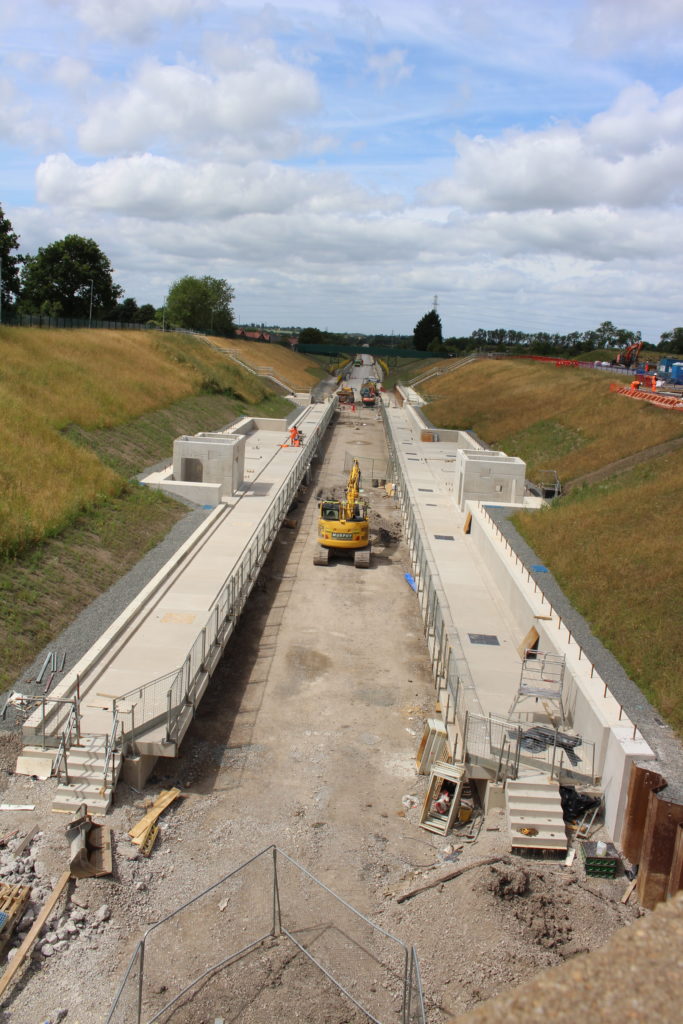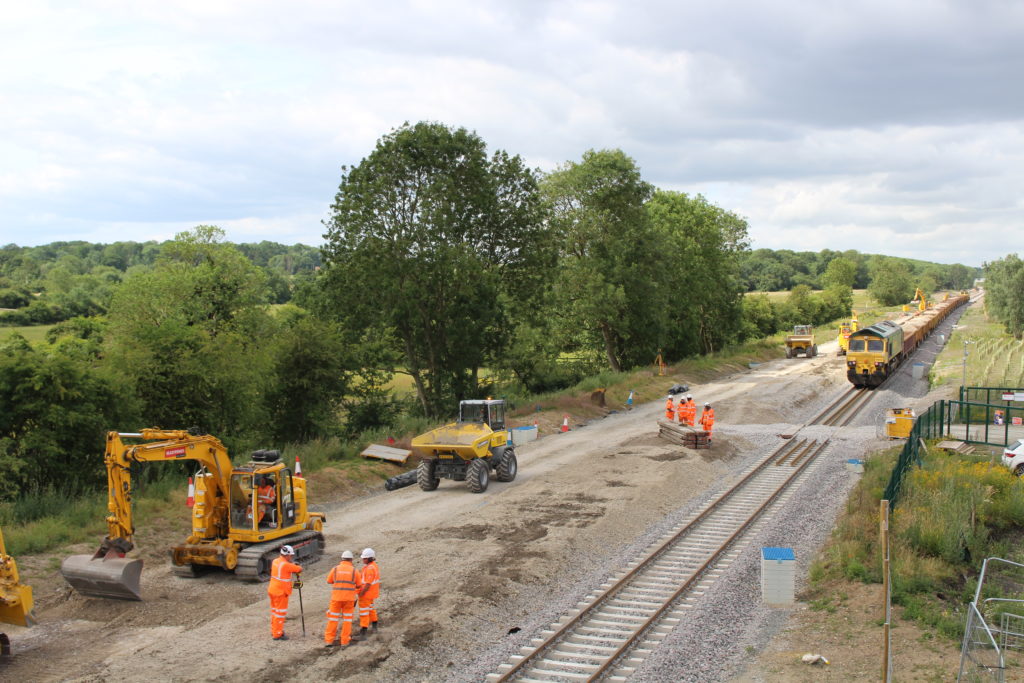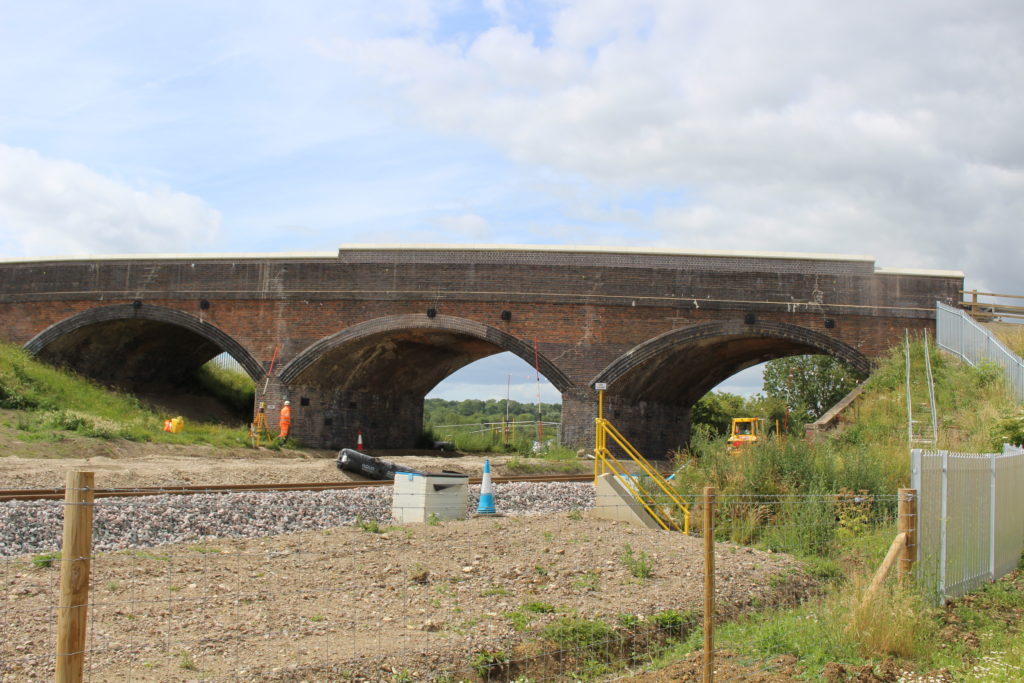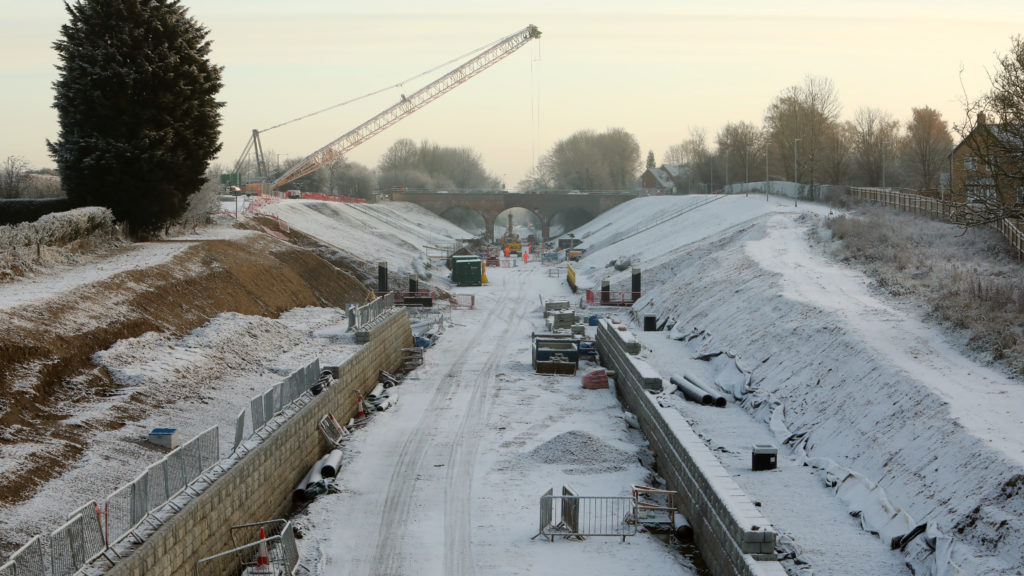The East West Rail scheme is a project originally intended to link the three major centres of Oxford, Milton Keynes, and Cambridge, sometimes known as the technology arc, in south-east England.
When completed, it will replicate and enlarge the catchment area of the old Varsity Line closed as a through route in 1968, with various sections having different fates. In summary, the section from Oxford to Bicester reopened as a shuttle passenger service in 1987 and the section from Bicester to Bletchley remained in use for occasional freight traffic but was eventually largely mothballed.

The section from Bletchley to Bedford initially remained open for freight due to the extensive brick workings and subsequent landfill opportunities, but also with a passenger service which is best described as low quality, often being replaced by buses.
Finally, the section from Bedford to Cambridge was disposed of and significant sections reused. For example, for Cambridge University’s Mullard travelling radio telescope, as part of the Cambridge guided busway, and for housing.
During the second world war, the route was seen as strategically important because it provided a route across the southern part of England at sufficient distance from London to provide a robust alternative.
In the early 2010’s, the potential for economic growth along the line was established. From a railway perspective, an early advocate was Chiltern Railways which saw opportunities in providing a short link at Bicester with other track upgrades, thus providing a regular Oxford to London Marylebone train service which started in 2016. In the meantime, both local and national government began to fully appreciate the economic opportunities along the route and looked at the enhancement of transport links both road and rail. Hence the birth of East West Rail.
Original plans
The initial plan for East West Rail was to rebuild the original route between Bicester and Bletchley, upgrade the route from Bletchley to Bedford, and to evaluate a number of options in terms of new routes between Bedford and Cambridge, with the aim of giving best journey times of around 90 minutes between Oxford and Cambridge.
Consideration was also given to using another largely disused rail route to provide services from Aylesbury to Milton Keynes. The plan included electrification of the route and the objective was to connect people and places enhancing the employment opportunities along the line. The existence of good travel options would also allow for greater development in terms of housing and employment along the route.
The 2021 consultation indicated a service pattern of two trains per hour from Oxford to Milton Keynes and a further two trains per hour from Oxford, initially to Bedford extending to Cambridge when the route was available. In addition, there would be a further two trains per hour from Bletchley to Cambridge. Freight is not excluded but isn’t a prime focus, fundamentally because rail freight is market led in the UK.
Work in progress
So, what is the current situation? Electrification with the rebuilding was abandoned some time ago partly as a result of the overspend on the Great Western route which was used by the then Minister for Transport as a reason to abort or curtail several electrification proposals. Yet electrifying a route as it is built is far less expensive than for an existing railway. Former Transport Minister Grant Shapps justified this by stating that ‘we’re building it in such a way that we can use, probably, the very latest technology’. This statement shows a lack of awareness of the inherent disadvantages of self-powered traction which makes electrification a future proofed technology.
In addition, the construction of HS2 affects the route from Aylesbury which is, at least at present, no longer part of the plan.
Considerable work is in progress on the western end of the route. Although not specifically part of East West Rail, there is a current project at Oxford worth around £160 million to provide improved junctions north of the station, an additional platform face, and a new west side entrance to the station which will help ensure Oxford is able to handle expanded traffic both passenger and freight.
In terms of East West Rail, substantial work is in progress between Bicester and Bletchley with a new bridge under construction at the intersection of the EWR line and HS2. This incidentally is the proposed location of a HS2 infrastructure maintenance depot, so the ability to bring material by rail would perhaps be a bonus.

A new station is under construction at Winslow and track is being relayed, working outward from both Bicester and Bletchley, as the renovation of the formation is completed. Whilst electrification work is not progressing, the reconstruction is being conducted to be electrification ready, so clearances and parapets are being modified where necessary. The aim is for the Oxford to Milton Keynes section to be ready for train service introduction in 2025 using existing self-powered (that is, diesel) multiple units despite Government commitment to withdraw diesel passenger traction by 2040.
Next stage
The consultation in 2021 was primarily concerned with the route east of Bletchley. The next stage of the formal consultation has not yet started and consequently no physical work is yet in progress. Clearly, the route east of Bletchley is challenging both in terms of upgrading the existing Marston Vale line to Bedford and the building of a new line onward to Cambridge.
It is 16 miles on the Marston Vale line from Bletchley to Bedford in which are packed 10 stations, 15 vehicular level crossings, and a further 16 other level crossings, mainly footpaths. Of the 15 vehicle crossings, nine are CCTV controlled, three are AHB, and three are user worked. With a desire to lift the linespeed from 60mph to 100mph, the level crossing risk will rise significantly requiring substantial rationalisation. Similarly, with 10 stations the transit time of a stopping service and a commercially competitive fast train is likely to prove challenging to timetable.
The consultation addressed both these issues, offering two options in terms of the stations: either merge some station pairs at new intermediate locations and stop all trains, or relocate Woburn Sands station and provide passing loops at the new station. The cost of these upgrades will be significant, and the method of working could have a significant impact on the service provided during the works. Will there be a prolonged closure with bus replacement, or can the work be done with the minimum of disruption?
Challenges
Bedford presents its own challenges. The approach is on a tight curve currently limited to 15mph and on which stands the single platform St Johns station. This is located near the hospital so is in a useful catchment area. The plan is to realign the route to provide two tracks with a 30mph speed limit and a new station. The track then weaves between two sets of stabling sidings for Thameslink trains before arriving at Bedford Midland. Bedford Midland itself is a difficult station. There is no platform on the up fast line, so all up trains from Corby or the East Midlands calling at Bedford need to be diverted to the up slow and use one of the three platforms otherwise used by terminating Thameslink trains.
Network Rail has its own proposals to provide a platform for the up fast trains and this was reflected together with two new platforms for EWR services in the consultation.
East of Bedford, the challenges get even bigger. The original Varsity route actually bypassed Bedford town to the south and continued to Sandy but sections have now been redeveloped so a new route would be required. In addition, reversing the train at Bedford would make achieving the anticipated journey time challenging so departure northwards from Bedford would be a preferred option. The consultation proposed such a route departing northwards towards Clapham before swinging northeast.
There were then several different route options crossing the East Coast Mainline either in the Tempsford area or somewhere just south of St. Neots, with an interchange station between the ECML and EWR whichever option is chosen. Earlier consultation had suggested that routes in proximity to the current main roads – the A421 and A428 – would be preferred and indeed the proposed options do that as far as Cambourne, a recently built town in South Cambridgeshire where a new station is proposed. Beyond Cambourne the routes merge and head south east past Haslingfield, not far from the Mullard telescope, to join the current Kings Cross to Cambridge route at Harston.

Objections
Upgrading of the route from Shepreth Branch Junction to Cambridge to four tracks was the last part of the proposals. This routing enables trains to enter Cambridge from the south to call at the new station at the Cambridge Biomedical campus and gives opportunities to continue north towards Ely, Norwich, Peterborough and even Ipswich via Bury St Edmunds subject to a tight curve, any of which may be useful to potential freight traffic.
Not surprisingly, the consultation threw up objections. In particular the proposals suggested separate tracks heading north out of Bedford which would require the demolition of several houses close to the current railway. The section from Cambourne in to Cambridge also met with significant objections as well as an argument for the route to serve another recent and continuing development at Northstowe requiring the line to arrive in Cambridge from the north. Arriving from the north was discussed as part of the documentation presented during the consultation which looked at the challenges this created. Several details of the final approach and platforming at Cambridge were left open meaning further work is expected.
Whilst separation of services at Bedford station is understandable from a train service perspective, the additional tracks north of the station are perhaps debateable assuming a suitable track geometry can be developed before Bromfield Road bridge around 300 metres north of the station. With Thameslink services terminating at Bedford, the slow lines north of the station largely handle freight traffic and should be able to cope with the proposed EWR services over the short distance to Clapham, especially if a platform on the up fast is provided.
However, from a railway operating perspective entry to Cambridge from the south is definitely the more flexible option. The challenge is that the objectors’ alternative was fairly well-argued and robustly developed.
Political appetite
The major question is what is the current political will around the next stage of development of EWR? The effects of the pandemic, together with the current spike in inflation and energy costs, suggest that transport funding, especially for rail, could be heavily restricted for some time. The objections raised by the consultation may also have influenced local political aims. Finally, the previous Secretary of State for Transport, Grant Shapps, made at least one statement indicating he was minded not to support further construction work on EWR, contrary to comments made in documents supporting the green agenda and the need to move to active and public transport.

One therefore concludes that until details of the eastern extension can be more firmly defined, and local political support can again be galvanised, there is likely to be a delay in completion of East West Rail through to Cambridge despite the opportunities it provides.
Perhaps disconcerting were the recent remarks made by Mr Shapps, who hinted he may consider “abandoning” further development of the route because of uncertainty around the project. This despite authorising major expenditure on the A428 road which provides the alternative. However, following the recent change of leadership there are signs that infrastructure developments may form part of the ‘growth agenda’. It therefore seems likely little further progress will be made until the major political issues are resolved.

